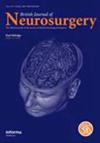脑膜瘤骨质增生:组织学相关性的回顾性研究。
IF 1
4区 医学
Q4 CLINICAL NEUROLOGY
引用次数: 0
摘要
目的脑膜瘤是最常见的原发性脑肿瘤。脑膜瘤通常伴有骨质疏松,但人们对其了解尚不全面。本研究旨在评估脑膜瘤相关骨质疏松与其他肿瘤变量之间的关系。材料与方法 我们回顾性分析了三年内接受手术的 245 例 263 级颅脑脑膜瘤患者(202 例为中枢神经系统 WHO 1 级,53 例为 2 级,8 例为 3 级)。邻近颅骨的脑膜瘤也包括在内。采用标准统计方法对人口统计学、放射学和肿瘤特征进行了分析。最常见的亚型为脑膜上皮型、过渡型、纤维型、非典型和无弹性。骨质增生与骨侵犯、中枢神经系统 WHO 分级和组织学亚型之间没有统计学意义上的显著关系。骨质增生在颅底脑膜瘤中比在凸面脑膜瘤中更常见(P = 0.001)。Ki-67指数与中枢神经系统WHO分级明显相关,但在考虑分级时与组织学亚型无关。无骨质增生的脑膜瘤的平均Ki-67指数更高(p = 0.03)。与骨侵袭没有关系(p = 0.29)。单变量和多变量分析显示,Ki-67指数与骨质增生呈负相关(p = 0.03),而骨侵犯(p < 0.001)和颅底位置(p = 0.03)与骨质增生呈正相关。没有骨质增生的脑膜瘤的增殖活性似乎更高,骨质增生与骨侵袭证据和颅底位置有关。本文章由计算机程序翻译,如有差异,请以英文原文为准。
Hyperostosis in meningioma: a retrospective exploration of histological correlates.
PURPOSE
Meningiomas are the most common type of primary brain tumour. Hyperostosis is commonly associated but remains incompletely understood. This study aimed to evaluate the relationship between meningioma-associated hyperostosis and other tumour variables.
MATERIALS AND METHODS
We retrospectively analysed 245 patients with 263 cranial meningiomas (202 CNS WHO grade 1, 53 grade 2, and 8 grade 3) who underwent surgery over a three-year period. Meningiomas adjacent to the skull were included. Demographic, radiological, and tumour characteristics were analysed using standard statistical methods.
RESULTS
Hyperostosis was evident in 99 (38%) of meningiomas. The most common subtypes were meningothelial, transitional, fibrous, atypical, and anaplastic. There were no statistically significant relationships between hyperostosis and bone invasion, and CNS WHO grade and histological subtype. Hyperostosis was more common in skull base meningiomas than in convexity meningiomas (p = 0.001). Ki-67 index was significantly related to CNS WHO grade but not histological subtype when grade was considered. Mean Ki-67 index was higher in meningiomas without hyperostosis (p = 0.03). There was no such relationship with bone invasion (p = 0.29). Univariate and multivariate analysis revealed that Ki-67 index was negatively correlated with hyperostosis (p = 0.03), while bone invasion (p < 0.001) and skull base location (p = 0.03) were positively correlated with hyperostosis.
CONCLUSIONS
Hyperostosis did not appear to be related to CNS WHO grade or histological subtype. Proliferative activity appeared to be higher in meningiomas without hyperostosis and hyperostosis was associated with evidence of bone invasion and skull base location.
求助全文
通过发布文献求助,成功后即可免费获取论文全文。
去求助
来源期刊

British Journal of Neurosurgery
医学-临床神经学
CiteScore
2.30
自引率
9.10%
发文量
139
审稿时长
3-8 weeks
期刊介绍:
The British Journal of Neurosurgery is a leading international forum for debate in the field of neurosurgery, publishing original peer-reviewed articles of the highest quality, along with comment and correspondence on all topics of current interest to neurosurgeons worldwide.
Coverage includes all aspects of case assessment and surgical practice, as well as wide-ranging research, with an emphasis on clinical rather than experimental material. Special emphasis is placed on postgraduate education with review articles on basic neurosciences and on the theory behind advances in techniques, investigation and clinical management. All papers are submitted to rigorous and independent peer-review, ensuring the journal’s wide citation and its appearance in the major abstracting and indexing services.
 求助内容:
求助内容: 应助结果提醒方式:
应助结果提醒方式:


